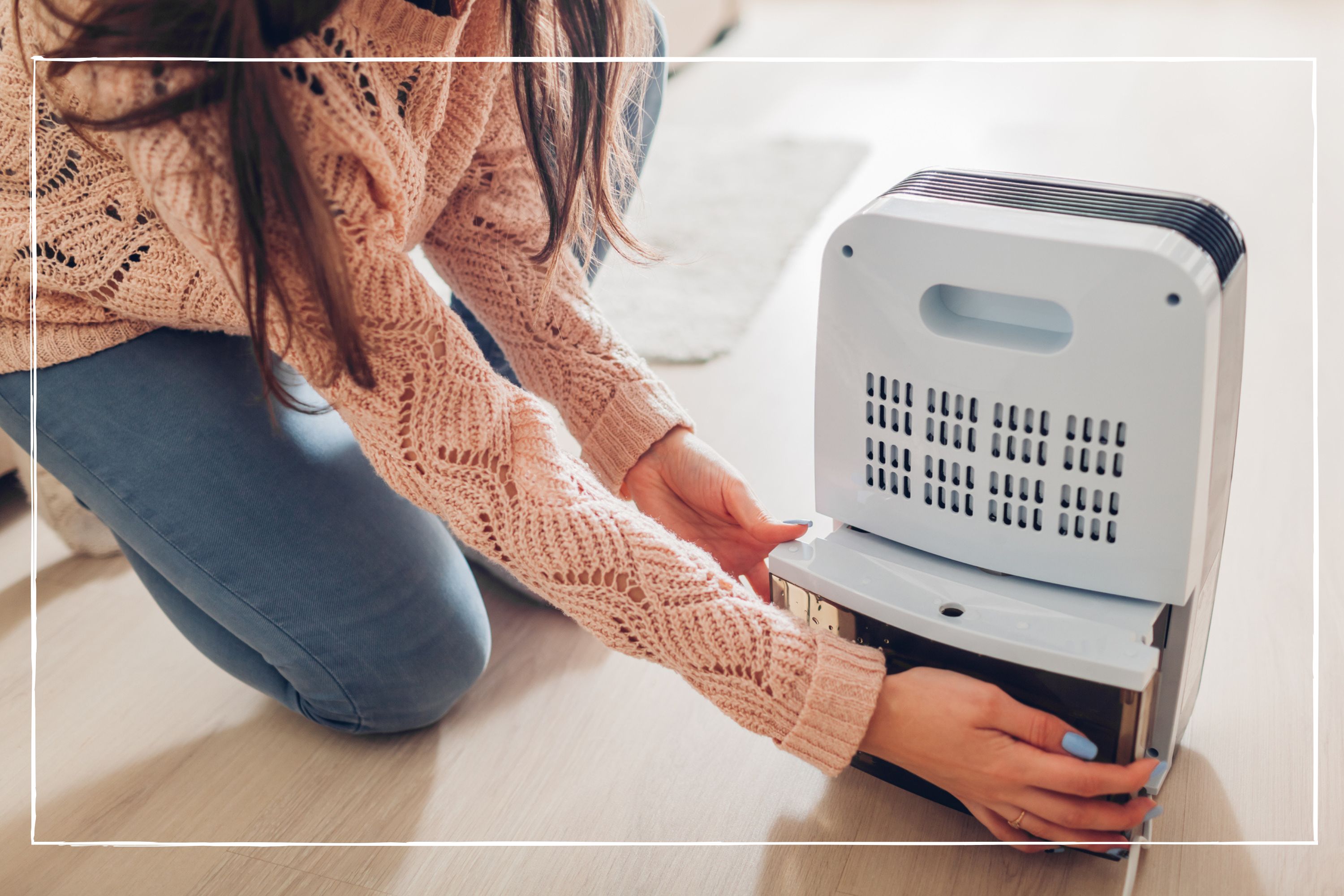How much does a dehumidifier cost to run and can you use one to dry clothes?
We calculate how much a dehumidifier costs to run and explain whether it's an effective choice to help you dry clothes indoors


Sarah Handley
Recent updates
The costs in this article have been updated in light of the new energy price cap coming into effect on 1 October 2023.
Want to know how much does a dehumidifier cost to run and could it help you dry your clothes? These are important questions to ask when changeable weather means it's harder to dry clothes outdoors.
Using a dehumidifier can help you to dry laundry faster indoors and is a great way to stop condensation on windows, while reducing the risk of mould and damp in your home. But it’s a good idea to understand exactly how much running one could be adding to your energy bill.
Even though the energy price cap has fallen, the price of energy remains high and households continue to be concerned about how much their energy bills will cost.
Goodto.com's Money Editor Sarah Handley says: "Energy prices have dropped since last winter, meaning bills will be more affordable for many families in the coming months. But they are still higher than they have been in recent years, so it makes sense to still be mindful about how much energy you are using and reduce it to keep your bills as low as they can be."
How much does a dehumidifier cost to run?
It costs around 6.8p an hour to run a typical 250W dehumidifier. If you used your dehumidifier for 12 hours a day, that would cost you around £0.82 per day or £17.68 per month, assuming you used it five times a week. If you ran your dehumidifier for five months of the year, your annual cost would be £88.40.
The exact cost will depend on the model of dehumidifier, including how much moisture it can extract and whether it automatically turns off when the humidity levels reach the preferred setting. It will also depend on how much you use it and how much you pay for your energy. For our calculations, we’ve used the October 2023 energy price cap’s electricity unit price of 27p per kWh.
Energy expert Paul Newman at review website housetastic.co.uk told us: “In order to calculate an estimated cost, you’ll need to know two things: the wattage of your dehumidifier, and the cost of your energy usage per pence/kWh of electricity. Portable dehumidifiers have an average wattage of 30-50 watts per hour, while full-home dehumidifiers use an average of 250 watts.”
GoodtoKnow Newsletter
Parenting advice, hot topics, best buys and family finance tips delivered straight to your inbox.
Once you know this, you can divide the wattage by 1,000 to convert to kilowatt hours and multiply the answer by your electricity unit price (if you can't see your exact unit price on your energy bill, you can use the 27p outlined under the energy price cap).
The table below illustrates how much it costs to run different dehumidifiers with different wattages.
| Header Cell - Column 0 | Cost per hour | Cost per day (12 hours) | Cost per month (if used 5 times a week) | Cost per year (if used for 5 months of the year) |
|---|---|---|---|---|
| 50W dehumidifier | 1.4p | 16.8p | £3.64 | £18.20 |
| 165W dehumidifier | 4.5p | 54p | £11.70 | £58.50 |
| 250W dehumidifier | 6.8p | 81.6p | £17.68 | £88.40 |
| 300W dehumidifier | 8.1p | 97.2p | £21.06 | £105.30 |
| 350W dehumidifier | 9.5p | £1.14 | £24.70 | £123.50 |
Can I use a dehumidifier to dry clothes and is it cheaper than a tumble dryer?
A dehumidifier can help you to dry clothes as it absorbs the moisture in the air from your wet clothes and projects warm, dryer air that helps to dry your clothes over time. When it comes to the cheapest way to dry clothes, the cost of running a dehumidifier is much lower compared to a tumble dryer too.
Energy expert Paul Newman says: “Dehumidifiers are an efficient way to remove the moisture from clothes, although the dry-time is estimated at around three to five hours compared to the average tumble dryer at 30-45 minutes. Although the dry-time is marginally higher, the costs are worth it.”
In terms of how much a tumble dryer costs to run, an average 8kg tumble dryer will set you back between £72.90 and £157.95 a year, based on using it twice a week. That’s more expensive than running a dehumidifier all day five days a week (£18.20 to £123.50 a year).
Check out these other expert tips if you want to know how to dry clothes without a dryer.
If you want to know how much other appliances cost to run, you might also be interested in:
- How much does it cost to boil a kettle?
- How much does it cost to run an air fryer?
- How much does it cost to run a microwave?
- How much does it cost to run a washing machine?
- How much does it cost to run an indoor heater?
- How much does it cost to run an electric blanket?
- How much does it cost to run a dishwasher?
- How much electricity does a TV use?
You can also use this comparison tool to compare how much your most-used appliances cost to run:
What can I do to cut the cost of using a dehumidifier?
The first step to cutting the cost of using a dehumidifier is to check the unit has a low wattage and high air flow rate. “This will ensure it’s cheap to run and works efficiently to dry your clothes,” explains William Hobbs from Myjobquote.co.uk.
“Make sure you are drying clothes outside as much as the weather allows. Then, transfer your clothes to indoor drying with your dehumidifier to finish it off. The dehumidifier method is best done in a smaller room to increase efficiency. Rotating your airer will also help clothes to dry evenly.”
Regularly vacuuming your dehumidifier’s filter will clear dust and particles and ensure it runs efficiently. You should also ensure that the unit’s vents aren’t blocked so that air flow is not restricted, and make sure all windows in the room are shut.
A further benefit of using a dehumidifier is that you might be able to turn the thermostat down, reducing your heating bills. Joseph Seager of thriftychap.com told us: “A dehumidifier can actually help you keep your heating costs down. This is because it removes the moisture from the air that makes you feel cold. So you might not feel the need to put the thermostat on as high a temperature.”
What energy saving features should I look for when buying a dehumidifier?
Look out for the following features when shopping for a dehumidifier:
Automatic timer
An automatic timer will enable you to specify how long you want to leave your dehumidifier running - reducing the time will reduce your energy bills.
Advanced humidistats
Humidistats measure the humidity and detect when it rises and falls. It switches off the dehumidifier once the required level of humidity has been reached. Advanced humidistats work more efficiently and will check humidity levels intermittently rather than continuously.
Variable speeds
Some dehumidifiers come with more than one speed which means you can have it on a lower setting when you don’t need to use it as much.
Where can I buy a dehumidifier?
You can buy a dehumidifier from a variety of high street or online retailers. Prices vary so be sure to shop around. For example, a 250W, 12 litre dehumidifier costs £150 from Argos, while a 350W 21 litre dehumidifier costs £309.99 from Screwfix.
There are two different types of dehumidifier so you’ll need to consider which best suits you:
- Compression or refrigeration dehumidifiers: these work in a similar way to a fridge. They draw in air from the room and pass it over cool metal plates where the warmer air condenses before dropping into a collection tank below. They are best used in warmer rooms such as living rooms.
- Desiccant dehumidifiers: these absorb water from the air using material that works like a sponge. They are better used in colder rooms such as conservatories.
Take a look at the following retailers to compare your options:
Now that energy prices are dropping, it might be worth thinking about how to switch energy suppliers to see if you can get a cheaper deal.

Mum of two, Rachel is a freelance personal finance journalist who has been writing about everything from mortgages to car insurance for over a decade. Having previously worked at Shares Magazine, where she specialised in small-cap stocks, Rachel developed a passion for consumer finance and saving money when she moved to lovemoney.com. She later spent more than 8 years as an editor at price comparison site MoneySuperMarket, often acting as spokesperson. Rachel went freelance in 2020, just as the pandemic hit, and has since written for numerous websites and national newspapers, including The Mail on Sunday, The Observer, The Sun and Forbes. She is passionate about helping families become more confident with their finances, giving them the tools they need to take control of their money and make savings. In her spare time, Rachel is a keen traveller and baker.
- Sarah HandleyMoney Editor, GoodtoKnow
-
 How to save money: 28 family-friendly money-saving tips for mums and dads
How to save money: 28 family-friendly money-saving tips for mums and dadsUnderstanding how to save money is key to limiting the impact of rising costs as much as possible
By Sarah Handley Published
-
 14 hidden benefits of your Amazon Prime membership
14 hidden benefits of your Amazon Prime membershipWe reveal the less-obvious perks of a Prime membership that will help you get the most value out of your subscription fee
By Rachel Wait Published
-
 14 surprising ways to spend your Tesco Clubcard vouchers - from restaurants and cinema passes to mini breaks and Disney+
14 surprising ways to spend your Tesco Clubcard vouchers - from restaurants and cinema passes to mini breaks and Disney+Tesco Clubcard vouchers can help you cut the cost of everything from groceries and travel to days out and cinema tickets
By Heidi Scrimgeour Published
-
 How to get Disney+ for free and save up to £79.90 a year
How to get Disney+ for free and save up to £79.90 a yearEven though the streaming giant ended its free trial offering, there are still multiple ways you can get Disney+ for free for up to 12 months
By Sarah Handley Published
-
 Parents of teens who have just taken their GCSEs urged to check child benefit status ahead of August deadline
Parents of teens who have just taken their GCSEs urged to check child benefit status ahead of August deadlineWith a child benefit deadline looming, some parents could see their payments reduced or stopped altogether - here's why
By Sarah Handley Published
-
 Parents should hold off buying this back to school staple 'as close to their first day as possible', says retailer
Parents should hold off buying this back to school staple 'as close to their first day as possible', says retailerWith parents turning their attention to kitting their kids out for the new school year, research suggestions which items should be left until the last minute
By Sarah Handley Published
-
 7 ways to save on back to school essentials, as its revealed parents will spend £2.3 billion in 2024
7 ways to save on back to school essentials, as its revealed parents will spend £2.3 billion in 2024We share ways you can get your child all the bits and bobs they need for the new school year, without breaking the bank
By Sarah Handley Published
-
 What day is child benefit paid around the bank holiday? Everything parents need to know
What day is child benefit paid around the bank holiday? Everything parents need to knowKnowing which day child benefit is paid when it comes to the bank holiday can help families plan their budgets accordingly
By Sarah Handley Published